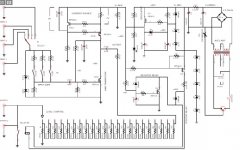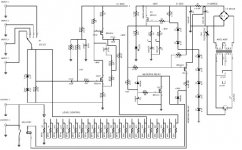I was just wondering if anybody had any opinions on the two versions of the Aleph L found in http://www.passlabs.com/pdf/aleph/al_serv_man.pdf The Aleph L Rev 1.2 is a very interesting circuit. But no one has built one yet most likely because it needs a stepped pot. Does anyone know what inspired the new topology and what the sonic differences are to the older always active version?
LBHajdu said:Does anyone know what inspired the new topology and what the sonic differences are to the older always active version?
Hi LBHajdu,
As it is common knowledge NP is a follower to Albert Einstein
"As simple as possible....."
You simply don´t need active circuitry at a gain below zero.
Therefore not even one active (polecreating) device is in the
signal path anymore!
Something that isn´t there cannot colour the sound!
Uli



Well there may be nothing in the signal path, however the gate of the first input mosfet will load it with a little capacitants. Some source outputs don’t have the current to run passive. I wonder why this design was never used in any other pre-amps opting instead for always active circuits. I can,t even tell if its really passive below the 6th to last contact.
I built both versions some 2 years ago.
As I remember I liked first version (all time active) much better.
And indeed Aleph L is excellent preamp , especially considering number of parts used.Aleph P 1.7 sounds better still but I can see it is pretty much balanced version of Aleph L with added negative CCS.
I'm not that wizz at knowing these topologies.It seems to me that untill some point second version works purely as an passive attenuator.If this is true I don't see the point of using it as in my expirence active preamp always sounds better than passive (especially driving Alephs).
There might be enough gain but there are other factors that make passive attenuators sound worst than good active circuit.
Bartek
As I remember I liked first version (all time active) much better.
And indeed Aleph L is excellent preamp , especially considering number of parts used.Aleph P 1.7 sounds better still but I can see it is pretty much balanced version of Aleph L with added negative CCS.
In fact many sources are not capable of being run passive.
I think this design wants to be "best of both worlds".
If its really passive or not, is a philosophical question
similar to "is Aleph really SE or not?"
I'm not that wizz at knowing these topologies.It seems to me that untill some point second version works purely as an passive attenuator.If this is true I don't see the point of using it as in my expirence active preamp always sounds better than passive (especially driving Alephs).
There might be enough gain but there are other factors that make passive attenuators sound worst than good active circuit.
Bartek
Aleph L
I agree with zygibajt.
I have built both versions of Aleph L and I think the original version sounds livelier, more dynamic with more control in LF and with more presence in the midband.
The only "drawback" is that it is phase inverting at the output but then I don't think it is actually a drawback.
Nick
I agree with zygibajt.
I have built both versions of Aleph L and I think the original version sounds livelier, more dynamic with more control in LF and with more presence in the midband.
The only "drawback" is that it is phase inverting at the output but then I don't think it is actually a drawback.
Nick
dependency
Normally a pre should not "sound" at all.
The reason why passive preamps tend to sound not as
"lively" as active ones is either the lack of coloration
or just poor quality of the source equipment. In most
cases the source is not capable of driving passive circuitry
and a powerstage.
Again I think this is a matter of philosophy, having lowest
possible number of gain devices in the signal path or not.
Uli



Normally a pre should not "sound" at all.
The reason why passive preamps tend to sound not as
"lively" as active ones is either the lack of coloration
or just poor quality of the source equipment. In most
cases the source is not capable of driving passive circuitry
and a powerstage.
Again I think this is a matter of philosophy, having lowest
possible number of gain devices in the signal path or not.
Uli



I must disagree Uli.
You are 10 times wiser in audio electronic and I admire your knowledge.
But in my expirence (tried many passive and active) active in 99% cases sounds better.And the only thing it looses with passive is a little liveness.Passive are always a bit lively and a tiny bit more natural.But they lack dynamic ,soundstageing and bass performance are very poor,and highs are dirty.
Less is better to some degree,but too less is not good.
Simple circuit like Zen or Son of Zen will never match more complex Aleph X or regular Aleph.
It's like with full range drivers.They are simple and in some aspect very very good,but if one is expecting a truly full range outstanding performance from top to bottom, there is no place for such simple solution like full range driver.
I think it is mostly impedance mismatch.The passive will never deliver such low output impedance as good active.
Bartek
You are 10 times wiser in audio electronic and I admire your knowledge.
But in my expirence (tried many passive and active) active in 99% cases sounds better.And the only thing it looses with passive is a little liveness.Passive are always a bit lively and a tiny bit more natural.But they lack dynamic ,soundstageing and bass performance are very poor,and highs are dirty.
Less is better to some degree,but too less is not good.
Simple circuit like Zen or Son of Zen will never match more complex Aleph X or regular Aleph.
It's like with full range drivers.They are simple and in some aspect very very good,but if one is expecting a truly full range outstanding performance from top to bottom, there is no place for such simple solution like full range driver.
I think it is mostly impedance mismatch.The passive will never deliver such low output impedance as good active.
Bartek
zygibajt said:I must disagree Uli.
You are 10 times wiser in audio electronic and I admire your knowledge.
Thanks very much!
I think it is mostly impedance mismatch.The passive will never deliver such low output impedance as good active.
Bartek
You are right in this case!
But I think this is a proof of poor source devices!
I owned a SONY CDP X77ES with Xformercoupled symmetric
output. After some tweaking it sounded best being passively
"preamplified" to my poweramps.
Uli



Ive been looking att the scematics (v1.2) and can´t understand how the input impedance can be 20Kohm..
Anybody care to explain?
And how do I calculate the output impedance? Looks to me like it schould be wery high?
If this were my design I would add a buffer-stage to the output..
Anybody care to explain?
And how do I calculate the output impedance? Looks to me like it schould be wery high?
If this were my design I would add a buffer-stage to the output..
Sony X77ES vs Kenwood DP-7090
Hi Uli,
how did you tweak your Sony X77ES?
I have owned such a unit for quite a while now and have always been satiesfied by its build quality and deep bass.
Today I did a quick comparison with a Kenwood DP-7090 (8x Burr Brown 1702, 32 fs, 22 Bit).
My initial assessment is that the 7090 creates the better soundstage and sounds easier on the ears. The 77ES appears to sound more forward and somewhat "clearer" but pays with sometimes too harsh a sound (for my taste). I still need to switch the units as I could not use identical cables, but I believe the differences are mostly due to the 1-Bit versus Multibit (and of course analog section) differences.
I would be interested to hear whether the Sony X77ES can be tweaked to sound smoother and create a soundstage with more depth (withouth giving Mr. Swoboda 1500 EUR).
Regards,
Tom
Hi Uli,
how did you tweak your Sony X77ES?
I have owned such a unit for quite a while now and have always been satiesfied by its build quality and deep bass.
Today I did a quick comparison with a Kenwood DP-7090 (8x Burr Brown 1702, 32 fs, 22 Bit).
My initial assessment is that the 7090 creates the better soundstage and sounds easier on the ears. The 77ES appears to sound more forward and somewhat "clearer" but pays with sometimes too harsh a sound (for my taste). I still need to switch the units as I could not use identical cables, but I believe the differences are mostly due to the 1-Bit versus Multibit (and of course analog section) differences.
I would be interested to hear whether the Sony X77ES can be tweaked to sound smoother and create a soundstage with more depth (withouth giving Mr. Swoboda 1500 EUR).
Regards,
Tom
Banned
Joined 2002
- Status
- This old topic is closed. If you want to reopen this topic, contact a moderator using the "Report Post" button.
- Home
- Amplifiers
- Pass Labs
- Aleph L v.s. Aleph L Rev 1.2

